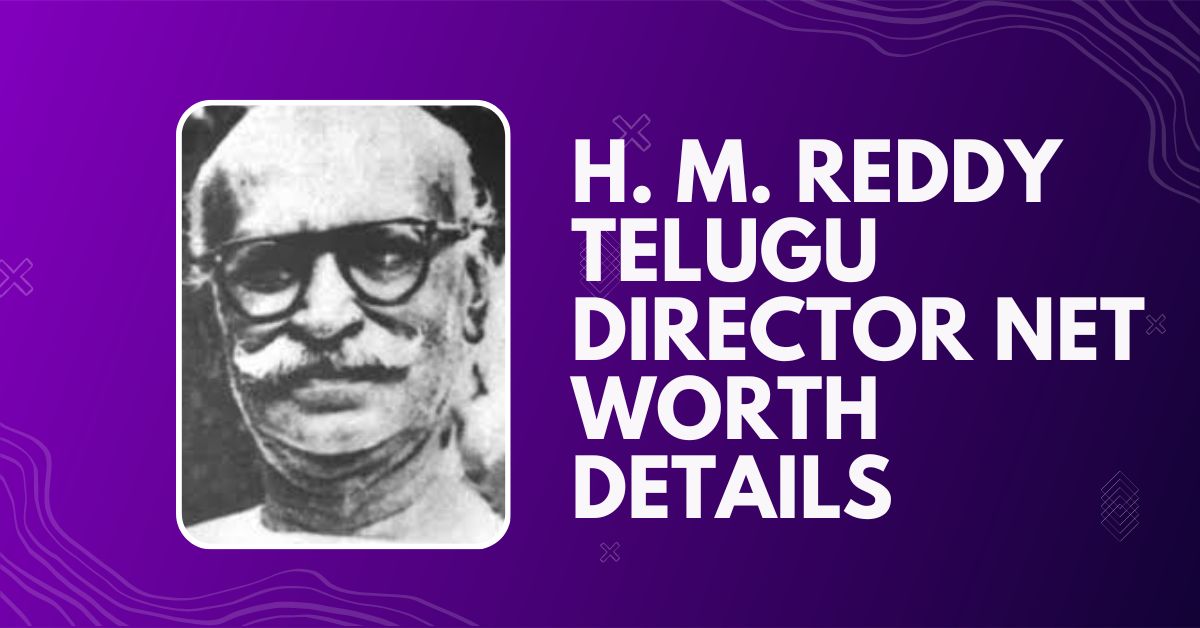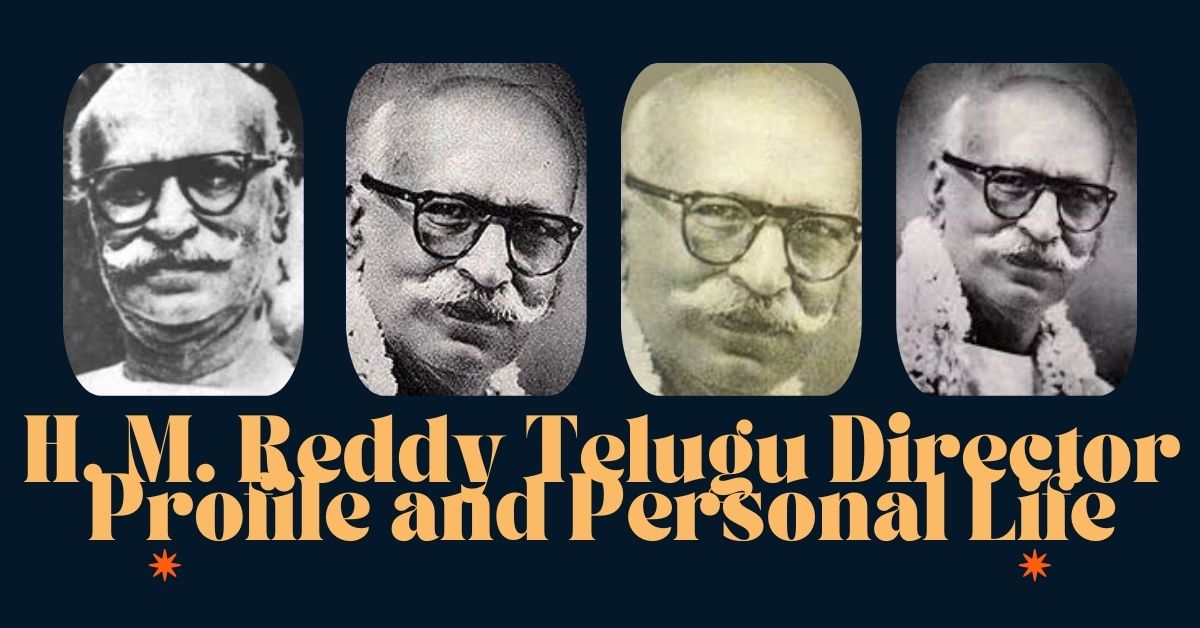Know the details about the H. M. Reddy Telugu Director Profile and Personal Life, H. M. Reddy’s Telugu Director Top Films, and Net Worth.
H. M. Reddy Telugu Director Profile and Personal Life
H. M. Reddy, also known as Hanumappa Muniappa Reddy, is a revered figure in Indian cinema, particularly in the Telugu and Tamil film industries. Recognized as a pioneering director and producer, Reddy made significant contributions to the early stages of South Indian cinema. His contributions, especially to Telugu cinema, laid the foundation for the film industry to thrive. This post delves deep into his personal life, career, and legacy, highlighting the life and works of one of the most influential figures in Indian film history.
Profile Overview
- Full Name: Hanumappa Muniappa Reddy
- Birth Date: June 12, 1892
- Birth Place: Thiruttani, Madras Presidency, British India
- Living Place: Primarily in Chennai (then Madras)
- Occupation: Film Director, Producer
- Years Active: 1930 – 1948
- Spouse: Not widely documented
- Children: Details not publicly available
- Education: Likely limited due to the period, with a focus on business and early cinema
- Death: January 14, 1960
- Legacy: Father of Telugu Cinema, First sound film in Telugu (1931)
Early Life and Education
Born in 1892 in the village of Thiruttani, which was then part of the Madras Presidency under British rule, H. M. Reddy grew up in a time when cinema was only beginning to emerge as a form of mass entertainment. His early life is not well-documented, but it is known that he grew up during a period of immense cultural change in India.
Reddy’s interest in cinema was sparked by the rise of silent films in the early 20th century. Given that formal education was a luxury at that time, it is likely that Reddy’s exposure to the arts and business was practical rather than academic. His entrepreneurial spirit and passion for cinema eventually led him to pursue filmmaking, making him one of the earliest directors in India.
Personal Life
H. M. Reddy’s personal life is shrouded in some mystery, as details about his family, spouse, and children are not widely known or documented. Given the social norms of the early 20th century, it is possible that Reddy led a traditional family life, but he is more remembered for his professional achievements.
While there is no extensive documentation on his marital life, it can be assumed that he focused intensely on building his career in cinema, which was an uncharted industry at the time. His pioneering work in the film industry speaks volumes about his passion and dedication to the craft, which may have come at the cost of publicizing his personal life.
Journey into Filmmaking

Early Career
H. M. Reddy’s early career in cinema began during the silent film era in India. He started as an assistant director and later became a film producer. His initial years in the industry involved working on a variety of projects, where he learned the technical aspects of filmmaking, such as camera work, editing, and film production. His experiences during this period provided him with the necessary skills and confidence to venture into directing.
First Major Breakthrough: Bhakta Prahlada (1931)
In 1931, H. M. Reddy directed the first Telugu talkie, Bhakta Prahlada, which was produced by Ardeshir Irani’s Imperial Film Company. This film marked a watershed moment in the history of Telugu cinema, as it was the first movie in Telugu with sound. Until then, Indian cinema largely consisted of silent films, so this was a revolutionary step forward.
Bhakta Prahlada was based on the well-known mythological tale of Prahlada, a devotee of Lord Vishnu, and his conflict with his father, Hiranyakashipu. The success of this film not only catapulted Reddy to fame but also solidified the position of Telugu cinema in Indian film history. His ability to merge sound with narrative storytelling earned him recognition as a groundbreaking director.
Contribution to the Telugu Cinema Industry
H. M. Reddy’s vision was not just limited to directing films. He was also a prominent producer and played an instrumental role in establishing the infrastructure for Telugu cinema. After the success of Bhakta Prahlada, Reddy produced several other films that contributed to the growth of the industry. He founded Rohini Pictures, a production company, which became a key player in South Indian cinema.
His work inspired other filmmakers in the region, and his influence can be felt in the works of subsequent generations of Telugu directors. By creating movies that appealed to local audiences, Reddy helped Telugu cinema evolve from its nascent stages into a major industry.
List of Films Directed by H. M. Reddy
| Film Name | Role | Year |
|---|---|---|
| Bhakta Prahlada | Director | 1931 |
| Kalidas | Director | 1931 |
| Gruha Lakshmi | Director | 1938 |
| Tenali Ramakrishna | Producer | 1941 |
| Satyam Eva Jayate | Director | 1948 |
Awards and Recognitions
Though formal film awards were not common during Reddy’s active years, his contributions were widely acknowledged by peers and future filmmakers. He is often credited with ushering in the era of sound films in South Indian cinema. Reddy’s “Bhakta Prahlada” is frequently cited in Indian film history as a cultural landmark.
H. M. Reddy Telugu Director Net Worth Details
Sources of Income:
H. M. Reddy’s net worth primarily came from his contributions to the film industry, including directing, producing, and occasionally writing films. Here are the key sources that contributed to his income:

- Film Direction and Production: As a director, H. M. Reddy helmed numerous films across various genres, including mythological dramas and social films. His production ventures also brought in revenue.
- Establishment of Rohini Pictures: In 1930, H. M. Reddy founded Rohini Pictures, one of the earliest film production houses in South India. This company produced several successful films and played a significant role in generating wealth for him.
- Technological Innovations: H. M. Reddy was instrumental in bringing new technology to Telugu cinema. His pioneering work in the talkie era meant that his productions were ahead of their time, attracting large audiences and increasing box-office returns.
H. M. Reddy’s Filmography and Financial Impact:
His portfolio of films expanded over three decades, contributing to his status as a wealthy director. Some of his noteworthy films included:
- Bhakta Prahlada (1931): The first Telugu talkie that established his reputation and brought financial success.
- Gruhalakshmi (1938): Another successful film that attracted large audiences and cemented his standing as a filmmaker.
- Other silent films and talkies, such as Kalidas (1931), a bilingual in Telugu and Tamil, were instrumental in increasing his wealth.
Net Worth During His Lifetime:
While exact financial records from the early 20th century are difficult to find, H. M. Reddy’s involvement in landmark film projects and ownership of Rohini Pictures suggests he was one of the wealthier filmmakers of his time.
- Estimates: Considering the success of his films and the influence of his production company, it is estimated that H. M. Reddy’s net worth at the peak of his career was substantial. His income would have been derived not only from his films’ box-office success but also from royalties, distribution rights, and technological innovations he brought to the Indian film industry.
- Value of Film Projects: Many of his films had large budgets for their time, and their success meant considerable returns on investment. Moreover, his ability to produce and direct a wide variety of films enhanced his financial growth.
Legacy and Financial Impact After Death:
H. M. Reddy passed away on 14 January 1960. Even after his demise, his legacy continues to influence Indian cinema. The films he directed are still celebrated today, with retrospectives of his work contributing to continued financial appreciation. His descendants and the legacy of Rohini Pictures continue to benefit from his pioneering work, which has solidified his position as an influential figure in the history of Telugu cinema.
Factors Affecting H. M. Reddy’s Net Worth:
Several factors influenced H. M. Reddy’s financial standing throughout his life, including:
- The Film Industry’s Growth: As the Indian cinema industry evolved, H. M. Reddy adapted, allowing his wealth to grow along with the increasing popularity of films.
- Technological Advancements: By being an early adopter of sound in films, H. M. Reddy gained a competitive edge, leading to box-office successes and increased financial returns.
- Film Production Ventures: The establishment of Rohini Pictures, which produced numerous successful films, was a significant contributor to his net worth. Production houses typically reap long-term benefits from film royalties, which would have boosted his financial standing.
H. M. Reddy’s Lifestyle and Philanthropy:
Reddy lived a modest life, focusing more on his craft than on flaunting his wealth. He was known for his passion for filmmaking rather than material possessions. While details of his philanthropic ventures are scarce, his contributions to the Indian film industry were likely seen as his way of giving back to society.
H. M. Reddy’s Posthumous Value:
- Rohini Pictures: The production company he founded continues to be recognized as one of the pioneering firms in South Indian cinema.
- Cultural Impact: The films H. M. Reddy directed continue to be studied and admired, adding cultural and historical value that surpasses financial worth.
Controversies
H. M. Reddy led a largely controversy-free career, with most of his work being celebrated. The challenges he faced were primarily technical, as filmmaking in the early 20th century was fraught with difficulties related to technology, distribution, and production. However, his pioneering role in making “Kalidas” (1931), a Tamil film with Telugu dialogue, caused some initial confusion, as it blurred the lines between languages in Indian cinema.
Skills and Contributions
Reddy’s primary skill was his visionary approach to filmmaking. He had the foresight to see the potential of sound films when the rest of the country was still adapting to silent cinema. His technical expertise in handling early sound equipment and film production tools set him apart as a filmmaker.
Additionally, Reddy was known for his storytelling abilities, which allowed him to bring complex mythological stories like “Bhakta Prahlada” to life in a way that resonated with Indian audiences.
Contact Details
Unfortunately, no direct contact details are available as H. M. Reddy passed away in 1960. However, his influence can be seen through various film institutes and cinema archives that preserve his works.
Death and Legacy
H. M. Reddy passed away on January 14, 1960, leaving behind a legacy that continues to influence Indian cinema. His contribution to the development of Telugu cinema, in particular, is unparalleled. He is often referred to as the “Father of Telugu Cinema”, a testament to the impact he had on the industry.
His work in transitioning Indian cinema from silent films to talkies established him as a pivotal figure in the history of Indian film. His pioneering contributions paved the way for the future of South Indian cinema.
Legacy and Contribution to Indian Cinema
Pioneer of the Talkie Era
H. M. Reddy’s contribution to Indian cinema cannot be overstated. His work in transitioning Telugu cinema from the silent era to the talkie era set the stage for the future of the industry. The release of Bhakta Prahlada marked a new era in Telugu cinema, and it remains one of the most important films in Indian film history.

Founding of Rohini Pictures
In 1930, H. M. Reddy established Rohini Pictures, a production company that became an essential part of South Indian cinema. The company was responsible for producing several successful films in Telugu, Tamil, and other regional languages. By founding Rohini Pictures, Reddy not only produced films but also created opportunities for other filmmakers, actors, and technicians.
Influence on Filmmaking Techniques
Reddy’s work was known for its technical innovation. His ability to incorporate sound into films revolutionized the filmmaking process in South India. His pioneering efforts in sound synchronization and dialogue delivery were groundbreaking at the time. He also helped develop better camera techniques, lighting, and editing processes, which became standards for future filmmakers.
About H. M. Reddy
H. M. Reddy was a visionary filmmaker who dared to experiment with new technologies and storytelling techniques at a time when the film industry was still evolving. His works, particularly “Bhakta Prahlada”, have immortalized him in the annals of Indian cinema.
Things to Know about H. M. Reddy
- First Sound Film in Telugu: Reddy directed the first talkie in Telugu, “Bhakta Prahlada”, which is a significant milestone in Indian cinema.
- Multilingual Director: Reddy directed films in both Telugu and Tamil, contributing to the early growth of South Indian cinema.
- Cultural Impact: His films, especially those based on mythological stories, had a profound cultural impact on Telugu audiences.
- Technical Innovator: Reddy was one of the first to experiment with sound technology in South India.
FAQs about H. M. Reddy
Q1. Who was H. M. Reddy?
H. M. Reddy was a pioneering Telugu and Tamil filmmaker known for directing the first talkie in Telugu cinema.
Q2. What is H. M. Reddy’s most famous work?
His most famous work is “Bhakta Prahlada” (1931), the first Telugu-language sound film.
Q3. When did H. M. Reddy pass away?
He passed away on January 14, 1960.
Q4. What is H. M. Reddy’s legacy?
Reddy’s legacy is that of being the “Father of Telugu Cinema”, having introduced sound films to the Telugu film industry.
Q5. When was H. M. Reddy born?
H. M. Reddy was born in 1892 in Thammarajukotla, Chittoor District, Andhra Pradesh.
Q6. What is Rohini Pictures?
Rohini Pictures is a production company founded by H. M. Reddy, which played a significant role in producing early Telugu and Tamil films.
Q7. What challenges did H. M. Reddy face during his career?
H. M. Reddy faced several challenges, including technical limitations, resistance from traditionalists who favored silent films, and financial constraints. Despite these challenges, he succeeded in making innovative films.
Q8. What was H. M. Reddy’s contribution to Indian cinema?
H. M. Reddy was a pioneer in bringing sound to Telugu cinema, and his films helped establish the technical and narrative standards for future filmmakers.
H. M. Reddy’s role in shaping the future of Indian cinema, particularly in the Telugu film industry, cannot be overstated. His innovative approach to filmmaking and his pioneering efforts in introducing sound to Indian films have left an indelible mark. Today, he is remembered as one of the key figures who laid the foundation for what has become one of the largest film industries in the world.
Click here to learn more about H. M. Reddy Telugu Director Profile and Personal Life


1 thought on “H. M. Reddy Telugu Director Profile and Personal Life”